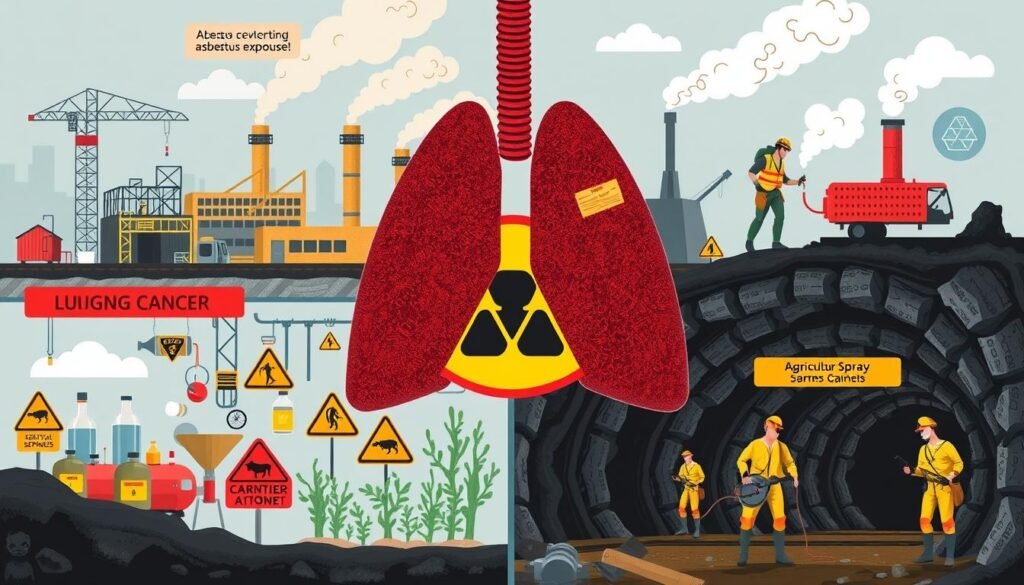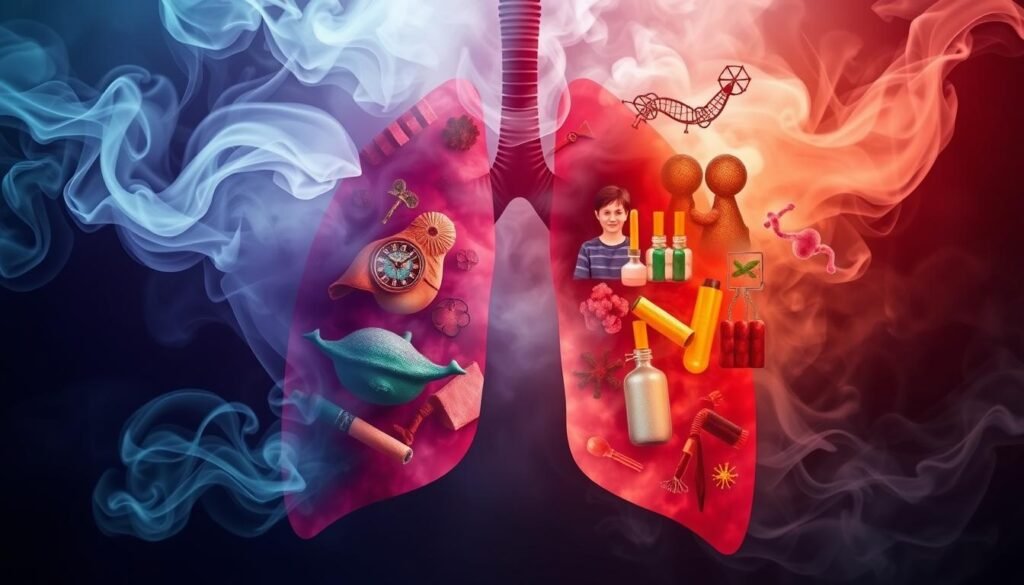Did you know about 80% of lung cancer deaths in the U.S. are due to smoking? This fact highlights why it’s vital to know about lung cancer. Smokers are not the only ones at risk. Secondhand smoke, radon gas, and certain jobs also increase the danger. Understanding these risks can help us fight lung cancer through prevention.
We’ll look closely at what raises lung cancer risk and how to avoid it. This knowledge could save lives.
Key Takeaways
- 80% of lung cancer deaths are linked to smoking.
- Radon exposure is the second-leading cause of lung cancer in homes.
- Occupations involving asbestos significantly increase lung cancer risk.
- Air pollution, notably diesel exhaust, contributes to lung cancer likelihood.
- Family history plays a role in a person’s risk of developing lung cancer.
- Radiation therapy for other cancers can heighten lung cancer risk, especially in smokers.
Understanding Lung Cancer
Lung cancer is a major health issue with two main types: non-small cell lung cancer (NSCLC) and small cell lung cancer (SCLC). NSCLC makes up about 85% of all cases. SCLC is rarer but much more aggressive. It’s key to know the different types to spot lung cancer symptoms early. These can include a constant cough, losing weight without trying, chest pain, and breathing troubles.
Lung cancer is the top cause of cancer-related deaths worldwide. Smoking is the biggest risk factor, causing nearly 90% of lung cancer cases. However, radon gas and hazardous chemicals exposure also play a big role. Smokers, especially heavy ones, are at high risk for SCLC.
Early detection and treatment of lung cancer are aided by recognizing its symptoms and understanding risk factors. Knowing your family’s health history and getting regular check-ups are crucial. This can significantly improve the fight against this disease.
The Leading Risk Factor: Smoking
Smoking is the top cause of lung cancer. Plenty of evidence shows its connection to the disease. Around 90 percent of lung cancer cases are due to smoking. Knowing the facts about smoking and lung cancer shows how critical it is to tackle this preventable cause.
Statistics on Smoking and Lung Cancer
Plenty of research shows shocking numbers on lung cancer. Stopping smoking could cut down lung cancer cases by up to 90 percent. Smokers are 15 to 30 times more likely to get cancer than non-smokers. People with lung cancer in their family have twice the risk. And if many relatives have it, their risk is even higher. This shows how genes and environment both play a role.
How Smoking Affects Lung Health
Smoking’s damage isn’t just about cancer. It harms overall lung health. Tobacco smoke has over 7,000 chemicals. At least 70 of these can cause cancer. Long-term exposure leads to conditions like COPD. This makes understanding smoking’s dangers key to preventing lung cancer.
Secondhand Smoke Exposure
Secondhand smoke is a big health issue, especially for nonsmokers. The risks of secondhand smoke are known to hurt adults, children, and pregnant women.
Health Risks of Secondhand Smoke
Being around secondhand smoke can lead to serious health problems. These include lung cancer, heart disease, and infections in the lungs. Non-smokers who breathe in secondhand smoke are 20–30% more likely to get lung cancer. Every year, more than 7,300 adults who’ve never smoked die from lung cancer in the U.S.
Kids are especially in danger from secondhand smoke. They’re more likely to get asthma, pneumonia, and other breathing problems. For pregnant women, secondhand smoke can cause their babies to be born too small. It is also linked to sudden infant death syndrome (SIDS), showing the importance of protection.
Protecting Others from Secondhand Smoke
To avoid secondhand smoke, we need to take action for smoke-free places. Here’s how we can protect from smoke:
- Make smoke-free zones at home and in cars.
- Do not smoke inside or in closed public areas.
- Talk openly with loved ones about not smoking near kids and non-smokers.
- Back laws that limit smoking in public spots.
More countries are making strict rules about smoking to protect people from secondhand smoke. Knowing the risks of secondhand smoke helps create a safer environment for all.
Radon Gas and Its Impact
Radon is a colorless, odorless gas from the natural decay of uranium in soil and rock. It’s the second leading cause of lung cancer in the United States. Both smokers and non-smokers can be affected, with non-smokers making up over 10 percent of radon-related lung cancer deaths. Knowing about radon is key to keeping your home safe.
What is Radon?
This radioactive gas builds up inside homes, especially in basements and low areas. Some homes have radon levels above the U.S. Environmental Protection Agency’s action level of 4 pCi/L. Annually, radon could cause 15,000 to 22,000 lung cancer deaths. Smoking combined with radon greatly increases lung cancer risk. The lung cancer risk increases by about 16% for every 100 Bq/m3 rise in radon level.
How to Test for Radon in Your Home
It’s vital to test your home for radon regularly. You can use DIY kits or hire pros for a detailed check. If radon levels are high, there are ways to lower them. Using passive systems can cut indoor radon by over 50%. Regular checks can guard against the health dangers of long-term radon exposure. For more info, visit this resource.

Asbestos Exposure and Lung Cancer
Asbestos is still a big problem because it can cause lung cancer. It used to be common in many jobs, which put workers at risk. Knowing which jobs are most affected is key for preventing problems.
Occupations at Risk for Asbestos Exposure
Some jobs have a high chance of coming into contact with asbestos. This increases the risk of lung cancer and other diseases related to asbestos. Positions in construction, shipbuilding, asbestos mining, auto repair, and insulation are especially risky.
- Construction
- Shipbuilding
- Asbestos mining
- Automobile repair
- Insulation work
People in these jobs need to be careful because no amount of asbestos is safe. For instance, auto repair workers might touch harmful fibers without knowing. Research supports the link to lung cancer, showing that even a little exposure can be dangerous over time. Check out the lung cancer link for more info.
The Risks of Low-Level Asbestos Exposure
Studies show that being around asbestos a lot, even if it’s not much each time, is really bad for your health. It can take years for any symptoms to show up, which makes it hard to catch early. Workers’ family members might also get sick from asbestos brought home on clothes.
Many health groups say asbestos causes cancer. If someone also smokes, their chance of lung cancer goes up even more. Research finds that asbestos exposure greatly increases lung cancer risk. This makes job safety and knowing about the dangers of asbestos super important.
Air Pollution’s Contribution to Lung Cancer
Air pollution is a big threat to our health. It’s especially true when talking about lung cancer. Harmful pollutants linked to cancer in the air increase the risk. Smoking is a major risk, but we can’t ignore air pollution. This is crucial for people in cities and industrial places.
Types of Air Pollutants Linked to Cancer
Dangerous substances get into the air from multiple sources. Some well-known pollutants harmful to our lungs include:
- Particulate Matter (PM2.5): With an aerodynamic diameter of ≤ 2.5 μm, PM2.5 can penetrate deeply into the lungs and bloodstream.
- Sulfur Dioxide (SO2)
- Nitrogen Dioxide (NO2)
- Carbon Monoxide (CO)
- Volatile Organic Compounds (VOCs)
Studies show being around these particles raises lung cancer rates by 30 to 50%. Learning how these pollutants affect environmental health is key.
Geographical Areas with High Air Pollution
Many industrial places have high levels of dangerous air pollutants. In the US, some areas expose people to cancer-causing pollutants. Even with efforts to reduce pollution, lung cancer deaths connected to air pollution continue. Around 1% to 2% of lung cancer deaths each year are due to this. Knowing which regions are affected is vital for health policies.
| Pollutant | Source | Health Impact |
|---|---|---|
| Particulate Matter (PM2.5) | Vehicle emissions, industrial processes | Linked to lung cancer and other severe health risks |
| Sulfur Dioxide (SO2) | Burning fossil fuels | Respiratory problems and aggravation of asthma |
| Nitrogen Dioxide (NO2) | Motor vehicles, power plants | Increases risk of lung infection and respiratory issues |
| Volatile Organic Compounds (VOCs) | Paints, solvents, fuels | Carcinogenic effects and potential lung cancer connections |
We need more studies and awareness about air pollution and lung cancer. Understanding this complex issue requires a lot of data and research. For extra details, you can check out more about lung cancer and pollution.
Family History of Lung Cancer
Understanding how genetics affect lung cancer risk is key. People with family members who had lung cancer face higher risks. This is true even when considering other factors like smoking. Having a close family member with lung cancer increases your risk by 1.51 times.
If that family member is a brother or sister, the risk is even higher, with an odds ratio of 1.82. This shows the strong impact family history has on lung cancer risk.
Genetic Predisposition and Lung Cancer
Hereditary factors play a big part in lung cancer. This is also true for those who have never smoked but have relatives with lung cancer. Having a sibling with lung cancer shows an odds ratio of 1.44. This underlines the need for family screenings and awareness.
| Family History | Odds Ratio | Population Group |
|---|---|---|
| First-Degree Relative | 1.51 | Adjusted for smoking |
| Sibling | 1.82 | Strongest association |
| Never Smokers | 1.25 | With family history |
| Never Smokers with Affected Sibling | 1.44 | Higher risk |
The need for vigilant health checks is clear for those with a family history of lung cancer. Knowing about hereditary factors can help catch the disease early. Early detection and action can lead to better results for those at risk.
Certain Occupational Exposures
Jobs involving certain chemicals can greatly increase lung cancer risk. Workers in fields like construction, manufacturing, and mining may be exposed to arsenic, chromium, and diesel exhaust. These substances are known workplace carcinogens, raising concerns for worker health and safety.
Carcinogenic Agents Found in the Workplace
Working with certain chemicals can make lung cancer more likely. Chemicals like chlorophenols, dioxins, and phenoxyacetic acids are particularly dangerous. Jobs in rubber making, iron and steel founding, and coal gasification see higher cancer rates. Even agriculture workers using harmful pesticides face increased risks.
The International Agency for Research on Cancer highlights the importance of safety. About 1.7 million cancer deaths a year are linked to unsafe work environments. This makes worker safety measures critical.
Mitigation Strategies for Workers
To keep workers safe from harmful exposures, effective safety actions are necessary. Key strategies include:
- Using personal protective gear (PPE) to reduce contact with dangerous chemicals.
- Improving air flow in work areas to lower carcinogen levels in the air.
- Offering training on the dangers of certain chemicals.
- Following safety rules and watching over workplace conditions closely.
By focusing on these strategies, we can better protect workers. This is key in lowering the risk of lung cancer from job-related exposures.

Previous Radiation Therapy
People who had radiation therapy for other cancers might have a higher chance of getting lung cancer. Radiation can harm lung tissue, which could lead to problems later. It’s important to look closely at how cancer treatment effects could happen.
Breathe Easy: Understanding Treatment Effects
Studies highlight why we must watch those who had chest radiation closely. Data from 47,911 lung cancer patients showed 19.1% had radiotherapy initially. This group’s outcomes varied, especially with secondary cancers.
Some research found a slightly lower risk for another cancer, with a Hazard Ratio of 0.89. But, radiation therapy has complicated effects. It could, for example, raise risks for esophageal cancer, with a Hazard Ratio of 1.76.
It’s crucial to keep checking lung health and general well-being after radiation therapy. By doing this early, we can spot issues or signs of lung cancer. Regular check-ups and being alert to new symptoms are key to catching changes early.
A study looking at patients from 1975 to 2011 sheds light on how past radiation affects lung cancer risks. These patients were followed for an average of 9.3 years, stressing the importance of long-term care. Their experiences show the complex nature of risk factors for lung cancer. They also highlight the need for detailed talks about treatment options and their lasting effects.
Explore more details regarding radiation therapy and lung cancer.
Chronic Lung Disease and Lung Cancer Risk
Chronic lung diseases greatly affect breathing health and increase the risk of cancer. Conditions like chronic obstructive pulmonary disease (COPD) and emphysema greatly raise the chances of getting lung cancer. Knowing this link is key for health and wellness.
Examples of Chronic Lung Diseases
A variety of conditions cause long-term breathing problems. Some key examples are:
- COPD
- Emphysema
- Chronic bronchitis
- Asthma
- Alpha-1 antitrypsin deficiency
The rate of COPD varies, affecting between 7.8% to 19.7% of some groups. Smoking is a big risk factor for COPD, with 75% of cases linked to smoking history.
The Link Between Lung Disease and Cancer Development
There is a clear link between chronic lung disease and lung cancer. Research shows people with COPD have a higher chance of dying from lung cancer. In fact, the chance of getting lung cancer in 10 years is 8.8% for those with COPD, but only 2.0% for those without.
Studies show a big link between emphysema and lung cancer. The risk varies from 1.9 to 4.7 based on scans. Also, even small drops in lung function raise the cancer risk, especially in women.

Handling chronic lung diseases well is crucial in lowering cancer risk. Early action helps lessen these diseases’ effects. This makes breathing easier and improves life quality for patients.
Factors That Increase Risk of Lung Cancer
Understanding lung cancer risk factors is key for health promotion. Smoking is the top cause, linked to over 60% of UK cases. Being around secondhand smoke also increases lung cancer risk.
Air pollution is another major factor, causing about 8% of cases. Radon gas, especially alongside smoking, raises the risk too. Workers exposed to diesel exhaust, asbestos, arsenic, and chromium face more danger. These factors show the need for safety in certain jobs.
Chronic illnesses like COPD and IPF also make lung cancer more likely. A family history of lung cancer increases one’s risk. Knowing these risks can guide prevention efforts.
Good prevention strategies sharply lower these risks. Getting regular health checks, spreading the word about smoking dangers, and discouraging tobacco use are crucial. A diet full of fruits and vegetables can also help reduce lung cancer chances.
Conclusion
Knowing what increases lung cancer risk is key for lung cancer prevention. In 2020, it was the top cause of cancer deaths globally, claiming around 1.8 million lives. Steps like quitting smoking and being aware of environmental risks can lower these numbers. This shows a clear need for health programs in areas with lots of smokers and other risk factors.
It’s crucial for public health campaigns to keep promoting better ways to manage the disease. Today, only 16.0% of people who should get screened actually do. But, getting yearly low-dose CT scans can cut death rates from lung cancer by 20%. As smoking is a major cause of lung cancer, raising awareness about smoking’s dangers is vital. Those who smoke are 22 times more likely to get lung cancer than those who don’t, stressing the need for support for those trying to stop.
Educating people about lung cancer risks and the power of early detection is a step towards a healthier future. If we all focus on lung cancer prevention and are more aware of our health, we can raise survival rates and save many lives.